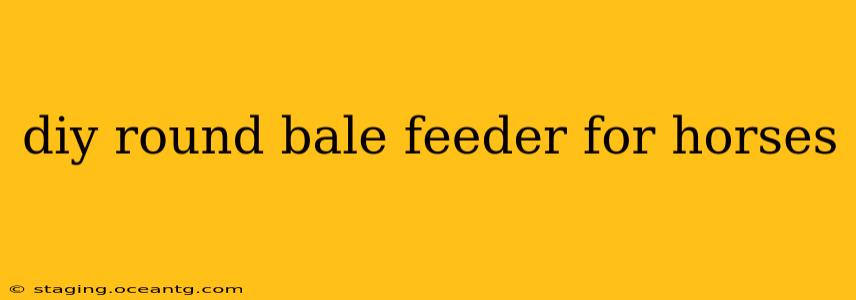Feeding horses can be expensive, and the cost of hay is a significant portion of that expense. Building your own round bale feeder can significantly reduce hay waste and save you money in the long run. This guide will walk you through the design, construction, and advantages of building a DIY round bale feeder for your horses.
What are the Benefits of a DIY Round Bale Feeder?
Building your own round bale feeder offers numerous advantages:
- Reduced Hay Waste: Horses are less likely to trample or waste hay when feeding from a structured feeder. This translates to significant cost savings over time.
- Controlled Feeding: A well-designed feeder can regulate hay intake, preventing overeating and potentially reducing health problems.
- Cleanliness: Feeder designs minimize hay waste and keep the feeding area cleaner.
- Cost Savings: Building your own feeder is considerably cheaper than buying a pre-made one.
- Customization: You can tailor the design to your specific needs and the size of your horses.
What Materials Will I Need?
The materials you’ll need depend on your chosen design, but common choices include:
- Heavy-duty posts: These will form the frame of your feeder and need to be sturdy enough to withstand the weight of the bale and the horses. Consider using pressure-treated lumber or metal posts for longevity.
- Heavy-gauge wire mesh: This will enclose the bale and prevent horses from getting their heads stuck or wasting hay. Look for wire with smaller openings to prevent hay from falling through.
- T-posts or other bracing: These will add stability to the structure.
- Welding equipment (optional): If using metal posts and wire, welding will be necessary for a more durable structure.
- Tools: Shovel, post hole digger, measuring tape, wire cutters, pliers, etc.
Different Designs for DIY Round Bale Feeders
There are various designs for round bale feeders, each with pros and cons. Here are a few popular options:
Simple Three-Sided Feeder:
This design involves driving three posts into the ground and attaching wire mesh to create a three-sided enclosure around the bale. It’s the easiest to build but offers less containment than other designs.
Four-Sided Feeder with a Roof:
A more robust design involves four posts and a roof to protect the hay from rain and snow. This provides better protection for the hay and adds extra durability.
Elevated Feeder:
Raising the feeder off the ground keeps the hay clean and dry and reduces the risk of horses injuring themselves. This requires more complex construction.
How Much Does it Cost to Build a DIY Round Bale Feeder?
The cost will vary depending on the materials you choose and the design complexity. A simple three-sided feeder might cost between $50 and $150, while a more elaborate design could cost up to $300 or more.
How to Build a Simple Three-Sided Round Bale Feeder?
- Choose a location: Select a level, well-drained area for your feeder.
- Set the posts: Dig holes and set three heavy-duty posts in a triangular formation, ensuring they are spaced appropriately for your bale size.
- Attach the wire mesh: Secure the wire mesh to the posts using wire ties or welding. Ensure the mesh is taut and secure.
- Place the bale: Carefully place the round bale into the feeder.
What Size Should My Round Bale Feeder Be?
The ideal size depends on the size of your bale and the number of horses you are feeding. Ensure there is enough space for all your horses to feed comfortably without competition.
What are Some Common Mistakes to Avoid?
- Using insufficiently strong materials: The structure needs to be robust enough to withstand the weight of the bale and the pressure from the horses.
- Improperly securing the wire mesh: This can lead to hay waste and potential injury to the horses.
- Poorly chosen location: Select a level area with good drainage to avoid mud and water damage.
Conclusion
Building your own round bale feeder is a rewarding project that can save you money and improve your horse's feeding experience. Remember to choose a design that fits your needs and skill level, use appropriate materials, and prioritize safety. By following these guidelines, you can create a durable and efficient feeder that will benefit you and your horses for years to come.
